Google Shopping has the potential to generate excellent returns for e-commerce businesses of all shapes and sizes. Once you have successfully set up your product feed and shopping campaigns, optimization should be next on the agenda to maximize Google Shopping ROAS.
Advertisers looking to advance their Google Shopping campaigns to new heights should consider the priority bidding structure of their campaigns, and how it can be used to increase ROAS.
- Structure your Google Shopping by campaign priority, whether it’s low, medium or high, to better tailor your bids.
- Use negative keywords in conjunction with setting campaign priority to control which campaign will enter into an auction for given searches.
- Subdivide your campaigns that are part of the priority bidding structure by product type to optimize for the performance of each product category.
- Select the right bidding strategy that’s right for your account and that enables you to reach your Google Shopping objectives.
- Use DataFeedWatch to further optimize bidding by segmenting your products using custom labels, which will allow you to categorize products with custom attributes.
What is Google Shopping priority bidding?
When setting up Google Shopping campaigns, advertisers have the option to set a priority level for each campaign. The campaign priority can either be low, medium or high and it’s a way to manage how Google prioritizes bidding on products.
For example, campaigns set to low priority will be of equal priority from a bidding and auction perspective. Then, campaigns set to medium will be given higher priority over low-priority campaigns, and so on.
By default, Google Shopping campaign priority will be set to low, which is best practice when running one campaign. If there are only a handful of campaigns and there isn’t a strategy in place on priority and structure, then it’s also best practice to select low priority.
Low priority will give all campaigns an equal chance in the auction. However, it is possible to implement a more advanced structure when it comes to priority, which could help increase ROAS.
Why use priority bidding on your Google Shopping campaigns?
Using an advanced priority bidding structure is a way to better prioritize products and search terms. It also enables advertisers to take into account product performance and advertising goals.
Rather than using a one-size-fits-all approach whereby all shopping campaigns are low priority, bids can be managed more efficiently based on the volume and quality of traffic.
For example, a beauty retailer selling Aesop face wash will want to show Google Shopping ads for the following searches:
- Generic search queries that are awareness-based and top-of-funnel, such as ‘face cleanser’, hydrating face wash’, ‘rosemary face wash’
- Branded search queries that are slightly more relevant to the product, such as ‘aesop face wash’, ‘aesop cleanser’, ‘aesop face products’
- Product-specific search queries that are the exact product being advertised, such as ‘aesop fabulous face cleanser’, ‘aesop amazing face cleanser’, etc.
Using an advanced priority structure, the beauty retailer will be able to keep bids lower for the high-volume generic search queries because these queries may generate a lower conversion rate.
Branded and product-specific searches, which may be lower in volume, will likely lead to higher conversion rates and ROAS, meaning advertisers will want to bid higher for these search queries.
The end result is implementing a structure that will help boost ROAS.
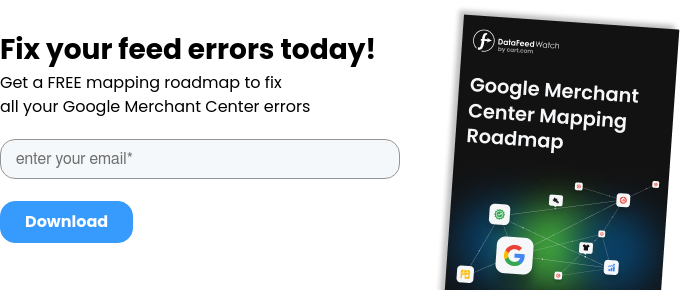
Google Shopping priority bidding structure
To set up a priority bidding structure, decide how to break out search queries by campaign based on search intent. High-intent search queries should be grouped together in a campaign, as should medium-intent queries and then low-intent queries.
Once search intent has been determined, negative keywords must be used in conjunction with setting campaign priority to either low, medium or high. This will control which campaign will enter into an auction for given searches.
source: Wordstream
The following table demonstrates how negative keywords should be used in conjunction with Google Shopping campaign priority:
|
Campaign |
Negative Google Shopping keywords |
Campaign Priority |
|---|---|---|
|
Campaign 1 Generic search queries Low intent |
Branded keywords, product name, product style and universal negatives |
High priority |
|
Campaign 2 Branded search queries Medium/high intent |
Product name, product style and universal negatives |
Medium priority |
|
Campaign 3 Product search queries High intent |
Universal negatives |
Low priority |
The priority setting is high for Campaign 1, however, brand and product search queries have been excluded. If a user searches for a brand keyword, Campaigns 2 or 3 will be triggered instead.
If campaigns 2 and 3 generate a higher ROAS, which in theory they should, then more budget can be allocated to these campaigns to maximize impression share.
Similarly, less budget can be allocated to campaign 1 if the objective is to increase conversions and ROAS.
Further product categorization with custom labels
Further optimize bidding by segmenting your products using custom labels, which will allow you to categorize products with custom attributes. This is another technique that advertisers use to boost Google Shopping ROAS by improving conversion rate and reducing wasted budget.
You have the option to add up to 5 custom labels to a product feed. The example below demonstrates how products can be labeled along with possible definitions and values that could be assigned to each custom label:
Using custom labels is not mandatory, however by segmenting products you will be able to bid higher for better-performing product categories that generate a higher ROAS. It provides more control over bidding, helps you to stay competitive, highlight sales and run experiments.
How to categorize products using custom labels
Using the beauty retailer as an example, products could be subdivided by product type into one of the following categories depending on how granular they need to go:
- Product category: skin care, hair care, body care and perfume
- Product type: face wash, toner, UV products, shampoo, conditioner, soap, moisturizer
- Brand: Aesop, malin+goetz, L’oreal, La Mer, Clinique, Kheils, etc.
However it is possible to take this further using custom labels, by creating rules to segment specific products or product groups by using "static value" in DataFeedWatch. It’s possible to extrapolate a word from any product attribute and populate a custom label column with that same word.
Doing so will enable the beauty retailer to segment products by a large number of other attributes, from season, sales, promotions, to profit margin, price point and performance.
- Margin: margin > 80%, margin >60%, margin > 40%, margin < 40%
- Season: SS24 new, SS24 sale, AW23 new, AW24 sale
- Performance: top selling 20% products, high value products, low value products
12 Custom labels and how to create them
Let’s explore 12 common custom labels used by advertisers to segment products and increase Google Shopping ROAS.
1. Based on sales and promos
Segment your products by sales, clearance, and promotions to isolate those products and bid higher on them, help you to stay competitive and spend your shopping budget more strategically.
It’ll help get these products greater visibility, which is ideal when running promotions and the goal is to move as much inventory as possible.

2. Based on margin
Split products by margin to bid more aggressively on high-margin products. This is a great way to boost performance because it takes into account the profitability of individual products, which is one step further than ROAS.
You can also reduce bids on lower margin products, meaning the budget is optimized and spent in the most profitable areas.
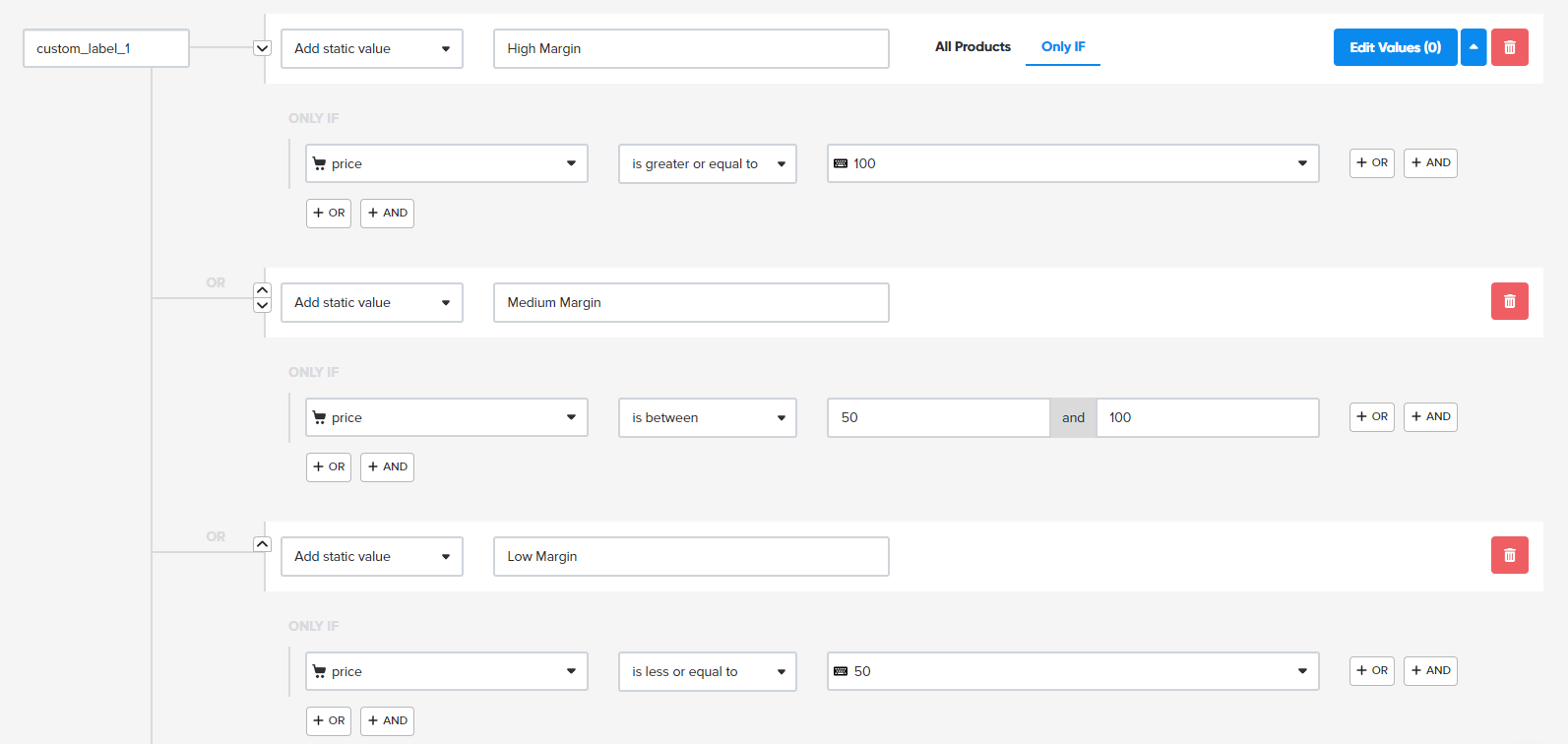
3. Based on price point
Consider the price point of your products and how that influences performance by using the price attribute and categorizing products by price point.
For example, it’s perhaps more profitable to bid higher on high-end items rather than low-medium-priced items.
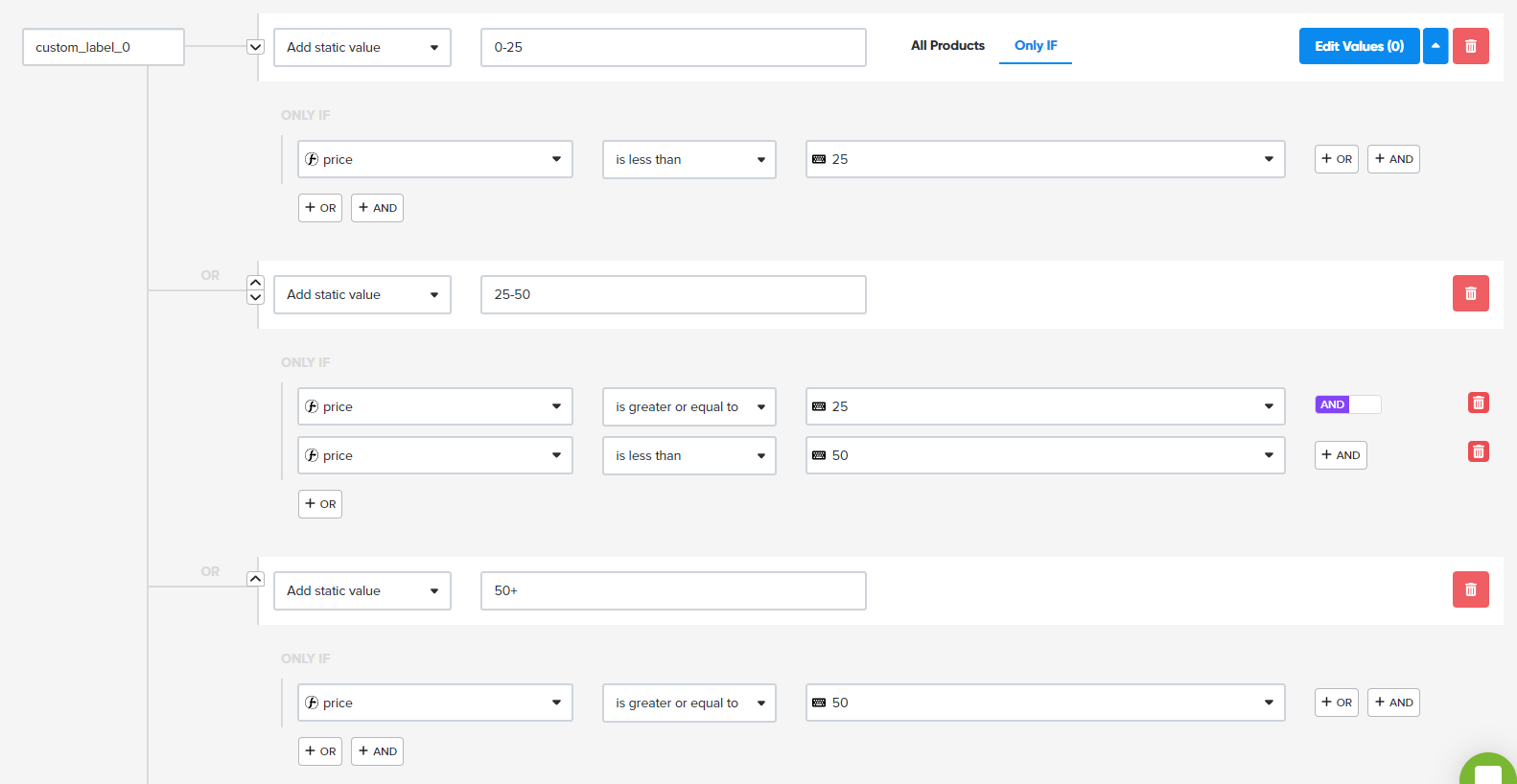
4. Based on price rank
Data on competitor pricing can be imported into the feed using a tool such as Price Watch, which will open the door to using price rank as a custom label.
When you are selling the same product as your competitors, segment your products by price rank to adjust your bidding strategy based on how your price compares to your competitors' price.
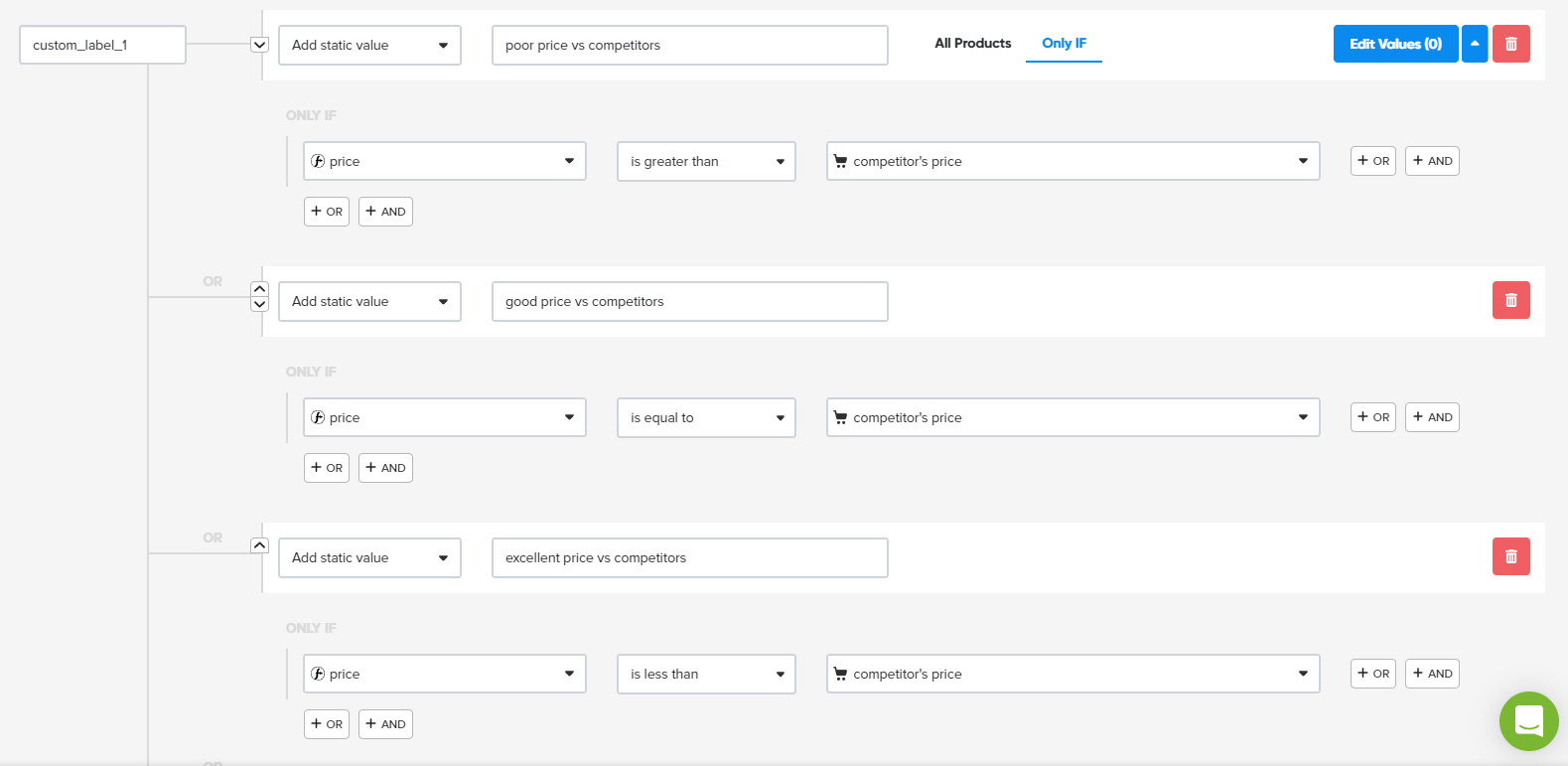
5. Based on product performance
Including a best-performing product group or campaign is a popular Google Shopping strategy that allows you to increase bids based on performance.
For example, having a category for top-selling products could be beneficial.

Better still, further categorize by combining top selling products with margin, so that you can focus on top selling products that are high margin.
6. Based on season
Exclude or lower your budget for seasonal items such as bathing suits, sandals, gloves, coats etc., and conversely, increase bids for those products when the time is right.
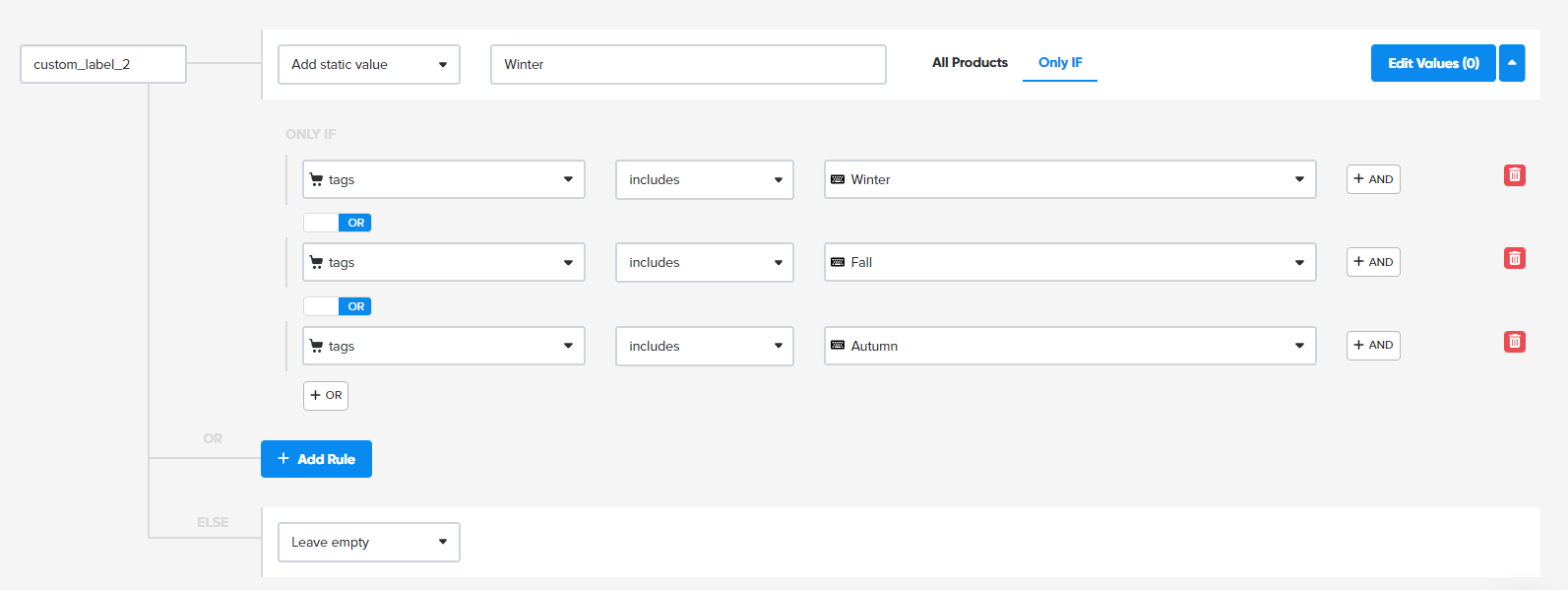
6. Based on shipping type
It’s possible to segment your products by shipping, whether you offer free shipping or tiered pricing. Or if you run special shipping offers, something that resonates with consumers, group products together in this way.

7. Based on season
Exclude or lower your budget for seasonal items such as bathing suits, sandals, gloves, coats etc., and conversely, increase bids for those products when the time is right.

8. Based on product sub-categories
Product category exists as a standard label, however, if your products require further segmentation use a custom label to do this.
For example, rings may still be too broad and instead, you would like to specify gold, rose gold, white gold and silver rings. Use a custom label to do this and then prioritize your budget based on how each product segment performs.
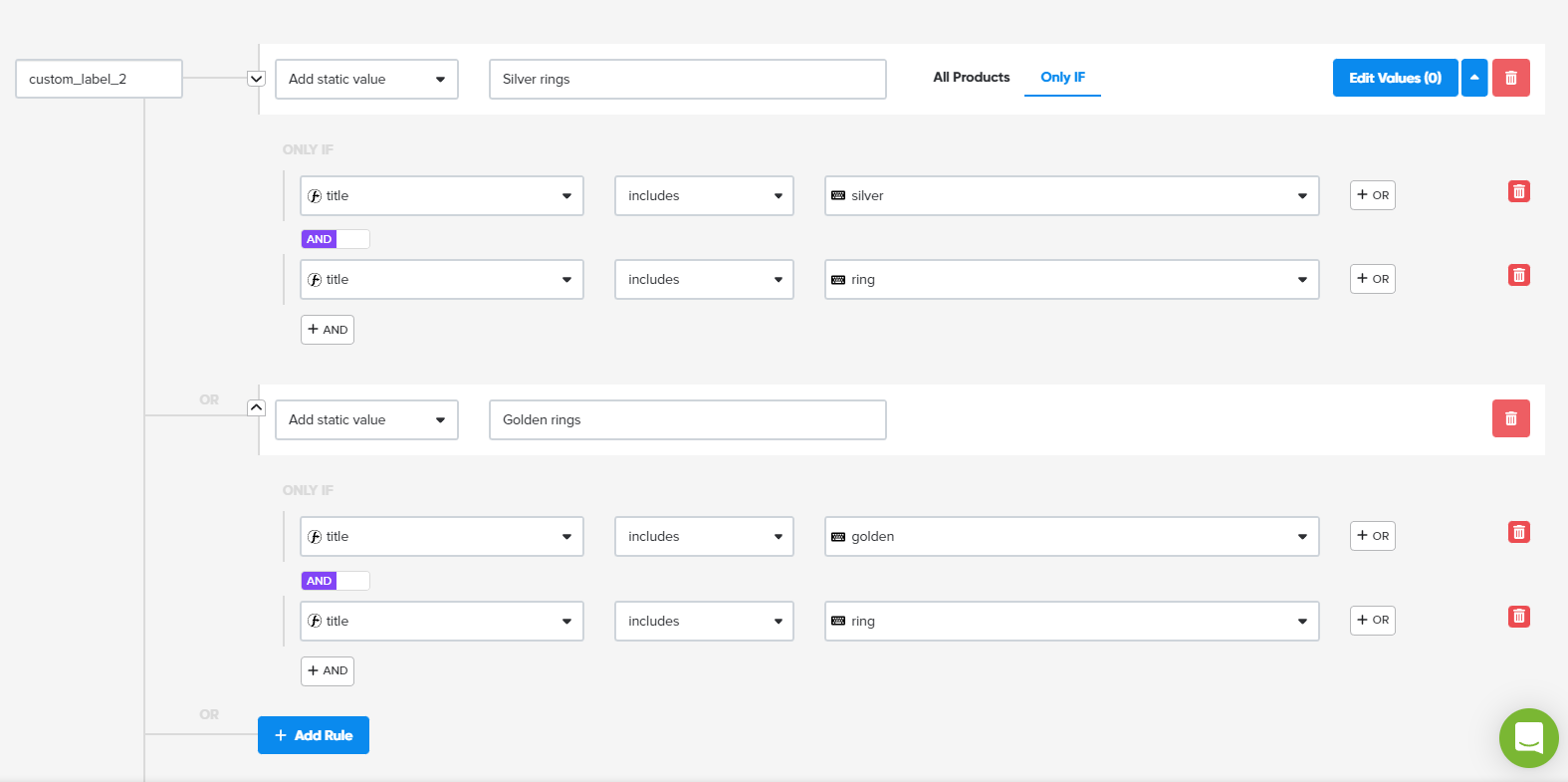
9. Based on gender
Create separate campaigns for products that are intended for a particular gender. The example below uses a custom label for female products:
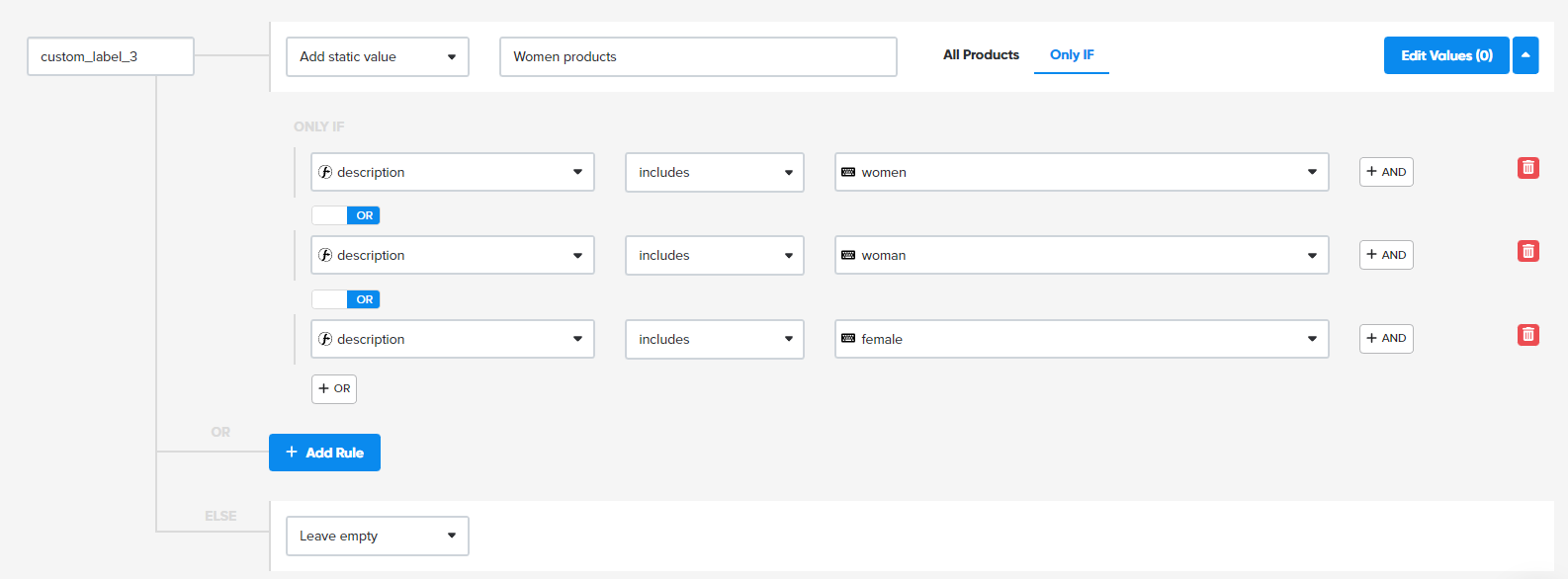
10. Based on size
Segment your products by size to bid more aggressively on bigger or smaller sizes. This allows you to stay competitive for best selling sizes.

11. Based on holidays
Only advertise certain products during specific seasons or increase / decrease budget and bids in line with holidays, for example Christmas, Mother’s Day, Halloween, etc.
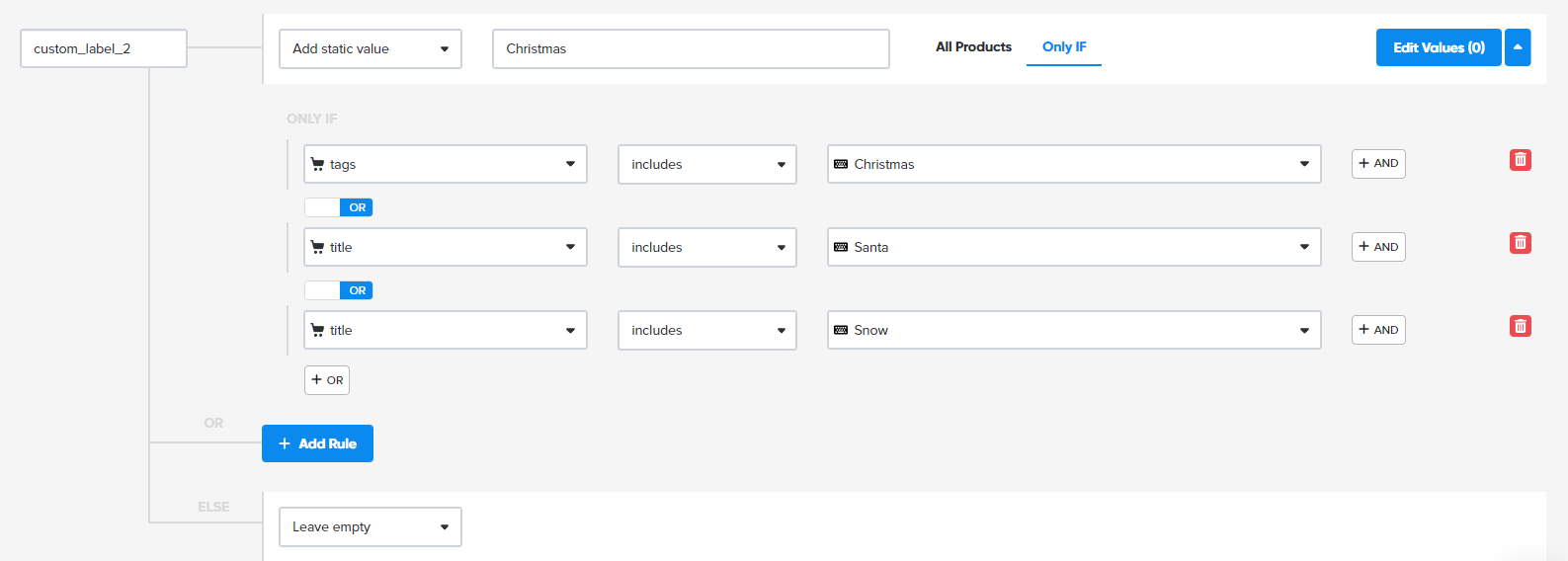
12. Based in in-house brands
Stores that also sell their own range of products can segment products by in-house brands to modify bids for them. This would be an effective strategy if in-house brands are more profitable or easier to ship.

These 12 popular ways to use custom labels can be implemented swiftly using DataFeedWatch. However, it is possible to use custom labels for almost anything else you can think of as well. It's worth exploring ways to segment your products to uncover what labels work best for you.

Bidding strategies for the Shopping priority structure
Choosing the right bidding strategy when using the Google Shopping priority structure is also an important consideration. Best practice differs slightly from that of Search and Display and there are four bidding strategies that could be a good fit for your Google Shopping campaigns.
Manual CPC
To retain full control over your bids, choose Manual CPC. This will allow you to set individual product group bids in Google Shopping campaigns and specify the maximum amount you are willing to spend on a click.
Manual bidding is becoming less common and the future doesn’t look bright for Manual CPC, however, it may still be a good option for advertisers that are just starting out and would like to have tighter control over their campaigns and bids.
The drawback to using Manual CPC is the time needed to meticulously manage bids, especially in larger accounts with a lot of inventory. Automated bidding also benefits from machine learning, something Manual CPC could miss out on.
To set optimal CPCs, take a look at past performance of other campaigns, ideally Google Shopping campaign CPCs, however Search can be used to guide Shopping CPCs as well. Set your CPCs in line with previous performance - too low and your ads won't deliver or will not be very competitive, too high and you risk wasting budget.
Maximize clicks
Maximize Clicks bidding strategy manages individual bids for you, saving a lot of time in the process. For this reason, it’s considered more optimal compared to Manual CPC. It’s also a good option for Google Shopping because the focus is on driving traffic to your website.
By setting a max CPC bid limit, you can control costs and provide the bidding strategy with some direction. This ensures the CPC you pay will never exceed the maximum CPC limit that you input. Set a realistic max CPC that’s in line with existing CPCs otherwise the campaign’s delivery may be limited.
Use the current average CPC as a guide when setting the maximum CPC bid limit. Then once the campaign has started delivering, increase the max bid limit to increase volume, or lower it if your actual CPC is lower than the maximum.
Enhanced CPC
Using Enhanced CPC is a slight upgrade on using Manual CPC and Maximize Conversions. It allows you to stay in control of bids, however, it’s designed to generate the maximum number of conversions within your budget. It’s not technically a stand-alone bidding strategy as it’s used alongside Manual CPC and Maximize Clicks.
Google will take into account how likely a user is to convert and adjust bids according to that, something that advertisers are not able to do manually. Therefore, using Enhanced CPC is more sophisticated and a better choice when conversions and ROAS are concerned.
Target ROAS
The clue is in the name - Target ROAS bidding strategy also referred to as tROAS, is the most optimal for increasing Google Shopping ROAS. It’s a smart bidding strategy that’s fully automated, benefitting from AI and designed to generate the maximum amount of conversion value from ad spend.
tROAS bidding strategy is an excellent choice for Google Shopping since revenue is the main focus, which is what Google calls ‘conversion value’. So rather than getting sidetracked by average CPC and how much you are paying for clicks, you get a clear understanding of how much return you are generating from a campaign.
For example, when using manual CPC you may be able to generate 500 clicks with a $1 average CPC. However, this may generate $0 in revenue. Whereas with Target ROAS, if the average CPC is $8 this means only 63 clicks would be driven from the same spend. If these clicks are of higher quality and lead to 5 conversions and $2,000 in revenue, this would equate to 400% ROAS. This demonstrates how CPC shouldn’t really be the focus when ROAS is concerned.
What is a good ROAS for Google Shopping ads?
There’s no right or wrong answer to determining what a good or bad Google Shopping ROAS is or what the target ROAS should be when setting up your bidding strategy. This should be decided on a case-by-case basis and it’ll depend on each individual business.
Here’s the formula for working out ROAS:
Revenue (total income from advertising) / Cost (total ad spend)
So if a Google Shopping campaign spends $5,000 and generates $10,000 in revenue, the ROAS would be 2, or 200%.
A company should then take into account their profit margin. If margin is 20%, then use this to calculate ROAS with the following formula:
100 / margin = Target ROAS
OR based on a 20% margin
100 / 20 = 5
This company would need to generate a ROAS of 5, or 500%, to be profitable.
Use this formula as a guide when deciding the Target ROAS for your Google Shopping campaigns. Using the example above, the recommended Target ROAS is 500%.
If campaigns are not serving or not spending all of your budget, the Target ROAS may be too high. If this happens, lower the Target ROAS to improve delivery, then overtime as more conversion data is collected and you are able to optimize, steadily increase the Target ROAS.
5 Best practices of priority bidding
If you’re ready to upgrade your Google Shopping strategy by putting a priority structure in place, ensure your campaigns are in with the best chance of generating the highest amount of ROAS.
Follow these five best practices from day 1 or if you want to improve the Google Shopping ROAS of existing campaigns.
1: Use accurate conversion data
For Google Shopping, having accurate conversion data in your Google Ads account is paramount for success. This will provide you with insight into the number of conversions and how much conversion value your campaigns are generating.
This is important for strategic decision-making and optimization work, plus it’s really important for smart bidding strategies to work effectively. Smart bidding, such as Target ROAS, will aim to generate the maximum amount of conversions and conversion value using the conversion data that’s flowing into the account. Inaccurate conversion data will lead to less reliable optimization and poorer performance.
As well as the need for conversion data to be accurate, there needs to be a sufficient amount of conversion data before using smart bidding. If the account receives less than 15 conversions in a 30-day period then opt for Maximize Conversions or Maximize Conversion Value bidding strategies first, until your account reaches the recommended minimum.
2: Experiment with bidding strategy
Safeguard performance and minimize any disruption to your Google Shopping campaigns by setting up bidding strategy experiments.
Let’s say your campaigns generate the recommended minimum number of conversions in a 30-day period and you are ready to test out tROAS in Google Ads, set up an experiment first. This way you can see what impact Target ROAS has on your campaigns and you can make sure it improves performance. If the results are positive, you can then switch over completely.
When considering how to optimize Google Shopping ads, don’t forget to experiment with the various ad components that make up a Google Shopping ad, which is another Google Shopping strategy designed to boost performance. There are ten components to consider from titles and descriptions, Google Shopping images and price, thorough to product attributes, annotations and labels.
3: Use negative keywords
Negative keywords are already part of setting up the priority bidding structure. As well as getting that part right, use negative keywords to prevent your shopping ads from showing for certain searches, saving budget and improving CTR at the same time.
Use negative keywords as early as possible in your campaign setup to prevent wasting your budget. Prevent your ads from showing for searches that are not a good fit for your products or that are low intent, such as free, used, guide, homemade, compare, discount, sale, and return.
These could all be added as negative keywords in phrase-match so that the campaign can focus on capturing high-intent traffic.
It’s also a best practice to monitor your search queries and negative keywords regularly and add new negative keywords as needed.
4: Allocate more budget to high-margin products
Although Google Shopping ROAS is important, go one step further than just tracking ROAS by also tracking profit-margin-based metrics, such as cost of goods sold (COGS), profit margin and profit volume.
This will help to improve the performance of your Google Shopping campaigns by getting that little bit more insight. You'll understand the relationship between product categories and profit margin and it will enable you to focus on the most profitable products.
For example, for the beauty retailer, both face wash and moisturizer products generate a 500% ROAS. If face wash products have a higher profit margin and generate more profit than moisturizer products, more budget can be allocated to face wash.
5: Consider seasonality and promotions
Take into account changes in demand due to seasonality, as well as changes in demand due to short-term promotional sales. Products that could be affected by seasonal demand and sales promotions should be separated into product groups or campaigns, which will allow you to adjust budgets and bids accordingly.
In spring and summer, there will be higher demand for sun cream with UV protection and products with SPF. With that in mind, it would be smart to increase budgets for these products in line with demand. Similarly, during winter, the demand for these products dips.
Or if a certain product or group of products are discounted for a special promotion, increasing budgets and bids for these products will provide greater visibility and help boost sales.
Considering seasonality and promotions is another way you can improve campaign performance and increase conversions and conversion value.

Conclusion
Using a priority-based Google Shopping campaign structure is a more advanced way to manage Google Shopping, one that is proven to increase Google Shopping ROAS.
Capturing traffic that’s high, medium and low intent is important for different reasons and the priority bidding structure means bids are aligned with the stage of the funnel that each campaign is targeting.
Read the ultimate guide to Google Shopping in 2023 to learn how to set up shopping campaigns and best practices. As well as that, discover how you can create a perfectly optimized product feed so that your ads perform well and in some cases even double ROAS.